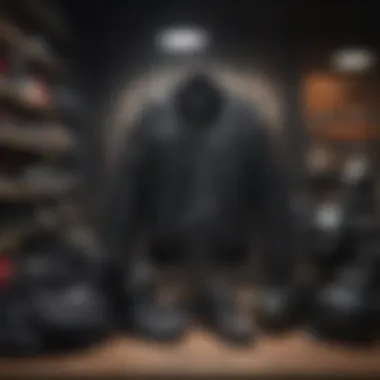The Significance of Black Clothing in Teen Culture


Intro
Black clothing has carved a distinct niche in youth culture, symbolizing rebellion, identity, and unity among teenagers. The universal appeal of black attire often resonates due to its versatile nature, allowing each wearer to convey deep personal symbolisms tailored to their lifestyle and individualistic expression.
Within the fabric of fashion trends, black style transcends generations. Historically, black clothing has linked to various movements, from punk to goth, evolving continually while holding its significance as a statement in everyday wear. Each of these cultural shifts shapes how teens perceive self and identity, establishing a framework for belonging or apartness within societal structures.
Moreover, adopting a predominantly black wardrobe comes with both advantages and drawbacks. On one hand, black is seen as chic and makes adults give it high regard. It can be practical, hiding stains and offering ease of matching. However, one might argue that an overreliance on black may limit creativity in style expressions or evoke misconceptions regarding the wearer's personality.
In this guide, we will explore the powerful role of black clothing in shaping youth fashion. We will discuss its inherent aesthetic appeal, psychological implications, practical dimensions, and current evolving trends. Youth narrative becomes more apparent as we delve into what drives teens to embrace this color on their journey of self-discovery.
Intro to Black Clothing
Black clothing holds significant relevance within youth culture. Its prominence can be traced across various social contexts, becoming a statement of individuality, rebellion, and group identity. Understanding the role of black attire is essential, especially as teenagers navigate complex social structures and seek to express personal taste. From its aesthetic appeal to the associations of strength and sophistication, black clothes resonate deeply with youth identity. Moreover, practical considerations such as durability and versatility make black a favored choice among teens and their hectic lifestyles. Black clothing often withstands the trials of daily wear while maintaining an unwavering stylishness that appeals to diverse subcultures.
Historical Context of Black Attire
The history of black attire is rich and layered. Initially, black clothing was primarily symbolic, often worn during periods of mourning. Over time, however, its meanings expanded significantly. In the 19th century, black evolved into a favored choice of formal wear among the upper class. It transcended beyond mere formality, signaling power and authority. As decades passed, it found its way into various movements, from the arts to punk, gaining associations with counterculture and nonconformity.
The 20th century witnessed a pivotal shift in perception. Designers like Coco Chanel popularized black as a color of elegance for women. Similarly, the punk rock aesthetic of the late 70s used dark clothing as a statement against mainstream culture. Historical moments like these have contributed to the significance of black clothing in fashion. Today, we see it transcending gender boundaries and incorporating various styles, allowing teens to explore their identities further.
Cultural Significance
Culturally, black clothing serves as a means of communication among teenagers. This color can symbolize a myriad of messages, often depending on the subcultural grouping. Black can represent rebellion, sophistication, or even melancholia, depending on the wearer and the broader context. In urban settings, streetwear often utilizes black as a grounding palette that emphasizes logos and graphic designs, marking a unique identity among peers. Furthermore, the influence of major artists and celebrities has undeniably cemented black clothing as an aspirational choice within youth culture.
Black clothing stands as a testament to how teens express personal beliefs, political stances, or social alliances through fashion choices. It often illustrates a deeper connection to individual and shared experiences.
Overall, it is clear that black clothing holds both historical weight and cultural significance. Understanding these aspects helps illuminate its enduring presence in the wardrobes of teenagers today. The conversation on black attire paves the way towards exploring trends, psychological implications, and practical considerations surrounding its use.
Trends in Youth Fashion
Understanding the trends in youth fashion is essential to comprehend how black clothing finds its place within this vibrant culture. Seeking trends helps identify what teenagers prioritize in their style choices. This awareness informs about self-expression, peer influence, and the ever-changing societal norms. With black clothing, its multifaceted usage appeals to different aesthetic preferences without compromising its core identity. Announcing personal style, achieving comfort, or performing functional roles are considerations that shape choices.
Current Trends in Black Clothing for Teens
Currently, black clothing for teens showcases various styles. Oversized t-shirts paired with baggy pants bring comfort yet coolness, while form-fitting dresses exhibit understated elegance. Layering is popular, where simple black basics combine with colorful accessories or shoes. Black hoodies and joggers, primarily from brands like Nike and Adidas, remain staples. Not just confined to casual wear, teenagers now experiment with business casual looks utilizing black blazers.
Key Features of Present-day Black Fashion:
- Versatile styling to transition for multiple occasions.
- Online influences dominate choices and trends.
- Black remains timeless, offering both bold statements or subtle dressing.
Comparison with Past Trends
Past trends diverged quite significantly from modern black clothing. The 90s spotlighted minimalism in black attire, focused on basic pieces like tank tops and straight-leg jeans. This era also favored grunge influences, where oversized black flannels symbolized rebellion. In contrast, today’s trends embrace eclectic styles. Beyond minimalism, combining black with vibrant hues or patterns reflects personal tastes more explicitly. Furthermore, the pursuit of unique cuts and textures previously lacked bulk and only hints at more diverse elements dominating weekly fistfights.
Distinct Features of Past and Present
- Limited style ranges in past trends
- Atmosphere of outright statement not retaining today
- Evolving appropriateness based on active niches in youth culture
Influence of Social Media on Fashion Choices
Social media's role in shaping fashion reaches impactful intensity, primarily for teenagers. Platforms like TikTok and Instagram allow quick exposure of styles. With viral hashtags, trends switch rapidly, leaving budding fashions short-lived or comprehensive. Users influence one another visually much faster than shops’ marketing campaigns reach traditional domains. Brands respond sometimes concurrently via energetic influencer promotions. More precisely, visual aesthetics over conceptual messages dominate the attention.
Social Media Redefines What is Visible: Platforms fuel not only choices but the connectivity in global influences.
This rapid demand often allows only limited impulse purchasing, potentially compromising adherence to more thoughtful investment in quality. Teenagers notable take cognizance—sometimes tempting flashy alone without attaching durable understanding. Yet, through careful selection, greater choice assists in evident declaration and conscientious representation of identity.


Psychological Implications
Understanding the psychological impact of black clothing among teenagers is essential. This color often symbolizes various aspects related to identity, self-expression, and social dynamics. For many teens, black is more than just a color; it's a conducting thread for personal narrative and internal struggles. Its association with emotional states provides a canvas where individual differences arise and contrast with social perceptions.
Association with Identity and Self-Expression
Black clothing can function as a powerful tool for self-expression in teens. With its inherent neutrality, black offers a versatile backdrop for numerous styles and statements. Teens often adopt black attire to cultivate a specific image or to communicate their identification with particular subcultures, such as goth, emo, or punk.
Moreover, wearing black can signify rebellion, individuality, or a status within peer groups. The choice of black extends beyond aesthetic preferences; it becomes a method of expressing thoughts, feelings, and beliefs.
Factors contributing to this association include:
- Desire for autonomy: Teens are in search of personal identity and differenation from their upbringing.
- Sense of belonging: Aligning with friends or lifestyle groups can be suited by wearing similar styles.
- Emphasis on mood: Colors often mirror their psychological states, and black can represent introspection or mystery.
Ultimately, black attire develops individuality and aesthetic identity.
Impact on Perception and Social Interactions
The influence of black clothing on how teens are perceived socially is profound. When a teenager chooses black garments, others may attribute characteristics like sophistication, confidence, or even defiance. This culminates in complex social interactions, shaping trust and acceptance levels with peers.
Societal Stereotypes
While black clothing may be regarded with admiration, it also invites negative stereotyping. Some individuals associate black with negativity, leading to the potential for misunderstanding a person’s intentions.
- Positive perceptions: Often individuals are seen as articulate or introverted.
- Negative perceptions: On other occasions, individuals may judge as withdrawn or potentially troubled.
Real-life Instances
In various themes such as teamwork or collaboration, wearing black can create feelings of unity or conformity, either aiding initiatives or limiting expressions profoundly. Situational contexts also dictate variation in interpretations.
As a conclusion, black clothing greatly affects identity, psyche, and social exchanges among teens. Understanding this can help both parents and educators create healthier environments during critical development years.
Practical Aspects of Black Clothing
The choice of black clothing is often driven by practical considerations. This section explores why these aspects matter, especially as young people create their fashion statements. Because black clothes can anchor numerous outfits, understanding their unique characteristics is essential.
Durability and Maintenance
One advantage of black clothing is its durability. Dark fabrics tend to play hide-and-seek with stains better than lighter colors. Spills or dirt might not stand out as harshly. Thus, fashion choices become less about constant laundry and more about wear and tear. However, maintaining the appearance requires specific care.
Cleaning Considerations
- Washing Frequency
- Detergents Used
- Drying Techniques
- Black items can become faded if washed too often. For maintaining the deep color, washing should be minimized when not necessary.
- Strong detergents can strip color, so using gentle options without bleach works best.
- Air drying in shade helps avoid fading from direct sunlight. Clothes can be damaged by dryers, is best recommended to air dry.
Investing time in caring for clothing can significantly extend their life span.
By mindfully coping with these elements, black clothing can remain fashionable and last longer.
Versatility in Wardrobe Combinations


The true strength of black clothing lies in its versatility. Individually, black items can serve various styles ranging from sleek to casual, making them perfect for diverse occasions.
Style Combinations
- Casual Wear
Combining black jeans with a simple tee or hoodie provides a laid-back aesthetic suitable for most casual outings. - Formal Situations
A tailored black blazer can transform a simple outfit into sophisticated. This option works for formal events such as school functions or interviews. - Layering Options
Black clothing pairs well with almost every color, which allows layering for seasonal changes. For instance, a black jacket over a bright shirt contrasts nicely.
With Accessories
Footwear also plays a role in versatility.
Black shoes adapt to any dark outfit, while accessories like scarves may introduce splashes of color.
A focused approach towards choosing black attire elevates both classroom style and casual outings.
It is a fashion staple that underscores one’s adaptability and personal branding.
Black Clothing across Different Subcultures
The significance of black clothing is undenialbe in various youth subcultures. Such attire often serves more than just a fashion statement; it can reflect identity, values, and a sense of belonging. For teens, wearing black can connect them to a larger community. Through this lens, we observe how distinct subcultures utilize black as a core element of their styles.
Goth and Emo Influence
The goth and emo cultures hold particular associations with black clothing. Adherents of these subcultures favor the deep shades, as they align with the emotional and often dark themes prevalent in their music and art. Black conveys a sense of rebellion, individualism, and deep emotion, appealing to many teens who find resonance with these values. Outfits often include black band tees, skinny jeans, chains, and accessories like dark nail polish or eyeliner.
Key Aspects
- Identity Expression: For many, it’s not merely about a preference for black; it reflects feelings of alienation or existential inspiration. Teens use black clothing to show alignment with these thought processes.
- Social Cues: The use of black also serves to signal affiliation. Social spaces often form around these aesthetics, where individuals actively showcase alignment through their dress.
“Black clothes become a form of non-verbal communication. It paints a picture of the struggles within.”
Skater Style
In skater culture, practical considerations meet fashion aesthetics. While not universally characterized by strict black attire, many skaters incorporate black into their wardrobes for durability and ease of cleaning. Often, black pants and hoodies blend function with style.
Elements in Skater Fashion
- Comfort and Durability: Black cotton or denim materials withstand wear and tear. Teens prioritize practicality during physical activities such as skating.
- Evolving Trends: The elements of skater style morph over time. The juxtaposition of rebellious aesthetics with comfortable fabrics aligns well with black’s versatility.
Urban and Streetwear Trends
Urban fashion often examines the intersections of culture and environment, prominently displaying black clothing. This involves the infusion of diverse styles and backgrounds, symbolizing both unity and individuality.
Features of Urban Streetwear
- Variety and Creativity: Streetwear regularly merges high-end and casual styles. Hoodies, graphic tees, and cargo pants in black are staples.
- Cultural Statements: Several brands embrace the color black as a means of denoting status and modernity. Urban wear uses logos, particularly on black backgrounds, creating iconography that appeals to youth worldwide.
The richness of black clothing across these subcultures reveals its multifaceted role in shaping youth identity while simultaneously reflecting broader societal trends. Its appeal resonates differently within goth, emo, skater, and urban styles, each providing a unique context through which black clothing can communicate personal and collective values.
The Role of Black Clothing in Extreme Sports
Black clothing plays a significant role in extreme sports, reflecting not only personal style but also practical benefits stemming from extreme environments. Just as athletes navigate various challenges, their clothing choices impact performance, safety, and identity. By utilizing black garments, young athletes can ensure functionality while adhering to aesthetic choices that resonate with their culture.
Practical Benefits in Extreme Environments
Wearing black clothing in extreme sports presents various advantages for athletes. The darker color helps absorb heat, which might be beneficial in colder conditions by allowing the body to maintain warmth. This aspect is particularly relevant for winter sports like snowboarding or skiing.


Additionally, black clothing tends to resist visible stains better than lighter options, a practical advantage during muddy outdoor adventures, rock climbing, or skateboarding. Maintaining a polished look can therefore become simpler.
Another benefit is dry Arizona Heat, where athletes engage in cycling or skateboarding under the sun. The color may also help conceal sweat marks during high-energy activities, contributing to a cleaner overall appearance.
In summary, here are the practical benefits black clothing offers:
- Heat retention in cold environments
- Concealed stains from spills or outdoor elements
- Sweat disguise during rigorous exercises
- Versatile wear suitable for various extreme sports
Fashion Trends among Extreme Sports Athletes
In the realm of extreme sports, black clothing is increasingly popular among athletes. Many athletes adopt a style that reflects a combination of functionality and contemporary fashion, integrating notable brands such as The North Face, Adidas, and Nike. These companies often release specialized collections with dark hues that bolster performance.
Athletes also embrace streetwear influence, making black an essential part of their overall aesthetic. As they transition from the sports arena to social spaces, black sportswear becomes a versatile option. This intersection shows how black attire is not merely about aesthetics; it resonates with community and lifestyle goals.
“Black stands as a canvas for self-expression within a diverse fashion landscape.”
The cycle continues as athletes utilize platforms like Instagram and Pinterest to showcase their outfits, driving peer trends and adopting styles from mainstream culture. Resultantly, black clothing gains a strong foothold in the wardrobes of young athletes not only for its practicality but for its lasting style in high-energy sports culture.
In summary, the fashion trends are:
- A blend of performance wear and streetwear influences
- Adoption by popular sports brands like The North Face, Adidas, and Nike
- Influences stemming from social media platforms promoting personal style
- A symbol of identity within the extreme sports community
Beyond practical advantages, black clothing in extreme sports speaks to a broader narrative about self-expression and shared culture. These threads combine the functionalities necessary for intense activities and the style elements central to identity and community formed by young athletes.
Challenges and Critiques
The examination of challenges and critiques surrounding black clothing is crucial to understand its role in youth culture. While black may be a central color in contemporary fashion, it can also raise issues that teenagers should consider. Examining these critiques offers insights into societal perceptions and enables informed fashion choices.
Stereotypes Associated with Black Clothing
Black clothing often encounters stereotypes that can shape societal perceptions. Many people associate black with negativity or rebellion. For instance, a common stereotype is that wearing all black indicates a person is gloomy or angry. This assumption can lead others to make unfounded judgments about a teenager's personality based purely on their color choices. This notion ignores the rich diversity in the motivations behind each individual's fashion decisions.
Importantly, such stereotypes can affect self-esteem. Teens who express themselves through black clothing maybe be unfairly tagged. In social contexts, they may face difficulties. To combat these stereotypes, education and awareness are key. Understanding the variety of reasons behind black clothing choices, ranging from fashion statements to cultural influences, can help shift perceptions. Teens should embrace their choices confidently, recognizing that clothing reflects one's individuality rather than a definitive mood.
Impacts of Overuse in Fashion
The monotonous application of black attire in the fashion world can lead to various complications. While black is a classic choice, its overuse can diminish its allure. As with any trend, if black attires dominate, they may lose their appeal and uniqueness.
Additionally, extreme reliance on a single color can pigeonhole personal style. Teens may forfeit the enriching experience of experimenting with a diverse color palette. This restriction in choices can be limiting. Striking a balance is essential. To retain the elegance of black in their wardrobe, teens should juxtapose it with occasional splashes of color. This not only broadens their fashion choices but promotes creative expression. Fashion, particularly for teens, should be liberating. Fostering diversity in outfits develops a deeper sense of individuality and personal style.
Culmination and Future Directions
The discussion on black clothing, especially among teens, reveals not just aesthetic preferences but also deeper cultural and social significances. As fashion evolves, so does the perception of black clothes. In this article, we examined how black clothing intersects with identity, creativity, and practicality. It's important to recognize several components as we move towards the future.
Evolving Perspectives on Black Clothing
Historically, black clothing has been tied to various cultural and social movements. As society changes, so do opinions on these garments. Today's youth sees black clothing as a statement of individuality and group belonging. It varies widely in styles, transcending age and occasion. A vital factor is inclusivity; black clothing fits different body types, representing shadows at once.
Moreover, the sustainability movement influences teens' choices. Many teens are increasingly considering the origin of their clothing. A focus on ethical sourcing within black fashion promises to reshape perceptions about the color itself. The cultural meaning of black attire continues to expand with societal shifts, addressing both traditional motifs and contemporary aesthetics.
The Future of Black Fashion among Teens
Looking ahead, the future of black fashion among teens appears vibrant yet challenging. Fashion cycles will inevitably include phases where black clothing may wane in popularity. Yet crucially, they often return renewed in appeal and relevance. The blending of characteristics invites ongoing innovation - designers are embracing technology, eco-friendly fabrics, and even digitalization.
Emerging trends will focus largely on individuality combined with community engagement. Teens will likely pursue to personalize their styles using mix-and-match techniques, layering fabrics, or keeping streamline comfort while elementing bold accessories. This reflects their desire for uniqueness blended with their peers.
Fashion is about more than just clothes. It is identity reflected in the choices we make.
Transformation in social platforms will additionally fuel teenagers’ need for self-presentation while grappling with how society views fashion markers—constantly shaped by social media.
The critical consideration lies with balance. As black garments evolve in usage, they must embrace practicality without draining individual narratives. Thus, our exploration not only highlights where black attire stands today but also sketches a thoughtful path forward, acknowledging elements that drive development in public perception and fashion cycles.



